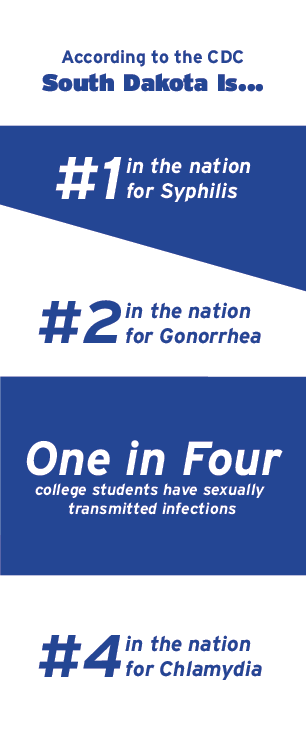Sexually transmitted infections (STIs) have reached a total of more than 2.5 million reported cases, according to data from the Center of Disease Control and this epidemic is affecting college campuses around the country.
One in four college students have an STI and although SDSU may not be as high in cases as other colleges, April Schneider a nurse practitioner at the student health clinic said there needs to be more education on campus about STIs.
“Honestly, it’s enough where I would say, yes, we need the education piece,” Schneider said.
People ages 15 to 24 account for almost half of the STI cases in the country and are highest among women ages 20 to 24, according to data from the CDC.
The most common STI seen on the SDSU campus and on campuses nationwide is chlamydia. Brookings County had 178 reported cases of chlamydia in 2021, according to data from the South Dakota Deparment of Health.
South Dakota is number one in the country for syphilis cases per 100,000 people, number two for Gonorrhea, number four for chlamydia and number three for overall rates. These high number come from bigger counties like Minnehaha and Pennington, but Schneider said this still has an impact on Brookings.
“We don’t have students that are just from Brookings here,” Schneider said. “Your partner might not be from here. So, the statistics that I’m looking at, are going to be skewed because your partner might come from a higher risk area, or a lower risk area.”
The student health clinic offers screenings for STI’s and Schneider encourages any student who is sexually active to be screened at least once a year or even every six months especially since some people will have no symptoms for these infections.
“It’s kind of down to the student or to the patient to take that responsibility to take that step and go forward with the screening piece…. We talk about the different symptoms that can come with different types of STDs,” Schneider said. “And sometimes we don’t get any symptoms at all. So that’s why it’s important to do a routine screening.”
Schneider warns students that these infections can be spread through more than just sex but only skin to skin contact.
“Some people will think that because they’re not having vaginal intercourse, that they can’t get an STD, but they can. We’ve seen patients with chlamydia in the throat,” Schneider said. “Herpes happens with skin to skin contact, and those are little vesicles, or little tiny blisters that can happen in the genital area. And that skin isn’t covered by a condom. And so that’s a risk.”
Although abstinence is the only way to ensure students don’t contract an STI, sexually active students can also help prevent the spread and contraction of these infections by getting screenings done and wearing condoms, according to Schneider.
The student health clinic is located in the Miller Wellness Center and is open from 8 a.m. to 7 p.m. daily and offer other services to students like pregnancy screenings, birth control and annual exams.

















